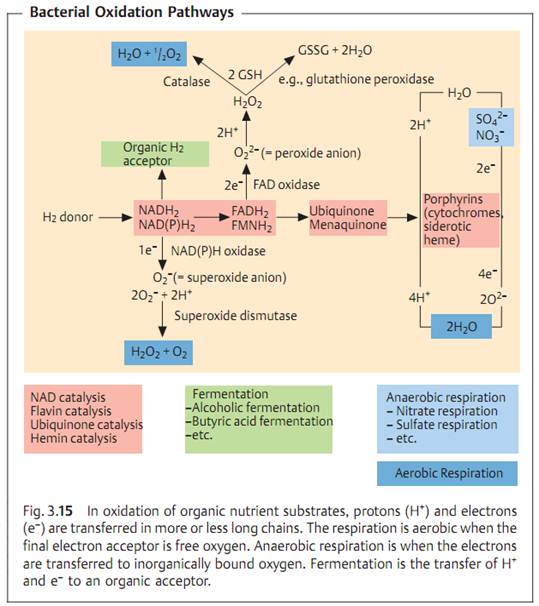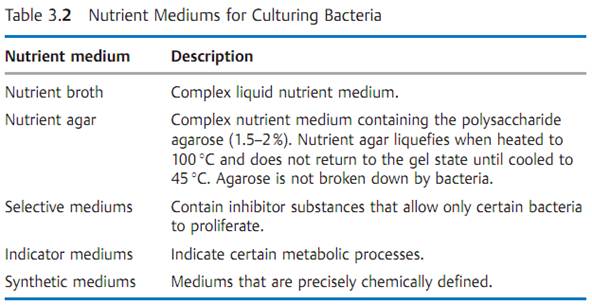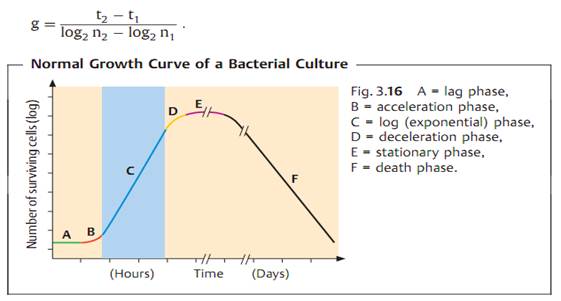The Physiology of Metabolism and Growth in Bacteria
Introduction
Human pathogenic bacteria are chemosynthetic and organotrophic (chemo-organotrophic). They derive energy from the breakdown of organic nutrients and use this chemical energy both for resynthesize and secondary activities. Bacteria oxidize nutrient substrates by means of either respiration or fermentation. In respiration, O2 is the electron and proton acceptor, in fermentation an organic molecule performs this function. Human pathogenic bacteria are classified in terms of their O2 requirements and tolerance as facultative anaerobes, obligate aerobes, obligate anaerobes, or aerotolerant anaerobes. Nutrient broth or agar is used to cultivate bacteria. Nutrient agar contains the inert substrate agarose, which liquefies at 100 °C and gels at 45 °C. Selective and indicator mediums are used frequently in diagnostic bacteriology.
Bacteria reproduce by means of simple transverse binary fission. The time required for complete cell division is called generation time. The in-vitro generation time of rapidly proliferating species is 15-30 minutes. This time is much longer in vivo. The growth curve for proliferation in nutrient broth is normally characterized by the phases lag, log (or exponential) growth, stationary growth, and death.
Bacterial Metabolism
Types of Metabolism
Metabolism is the totality of chemical reactions occurring in bacterial cells. They can be subdivided into anabolic (synthetic) reactions that consume energy and catabolic reactions that supply energy. In the anabolic, endergonic reactions, the energy requirement is consumed in the form of light or chemical energy—by photosynthetic or chemosynthetic bacteria, respectively. Catabolic reactions supply both energy and the basic structural elements for synthesis of specific bacterial molecules. Bacteria that feed on inorganic nutrients are said to be lithotrophic, those that feed on organic nutrients are organotrophic.
Human pathogenic bacteria are always chemosynthetic, organotrophic bacteria (or chemo-organotrophs).
Catabolic Reactions
Organic nutrient substrates are catabolized in a wide variety of enzymatic processes that can be schematically divided into four phases:
Digestion. Bacterial exoenzymes split up the nutrient substrates into smaller molecules outside the cell. The exoenzymes represent important pathogenicity factors in some cases.
Uptake. Nutrients can be taken up by means of passive diffusion or, more frequently, specifically by active transport through the membrane(s). Cytoplasmic membrane permeases play an important role in these processes.
Preparation for oxidation. Splitting off of carboxyl and amino groups, phos-phorylation, etc.
Oxidation. This process is defined as the removal of electrons and H+ ions. The substance to which the H2 atoms are transferred is called the hydrogen acceptor. The two basic forms of oxidation are defined by the final hydrogen acceptor (Fig. 3.15).
Respiration. Here oxygen is the hydrogen acceptor. In anaerobic respiration, the O2 that serves as the hydrogen acceptor is a component of an inorganic salt.
Fermentation. Here an organic compound serves as the hydrogen acceptor.
The main difference between fermentation and respiration is the energy yield, which can be greater from respiration than from fermentation for a given nutrient substrate by as much as a factor of 10. Fermentation processes involving microorganisms are designated by the final product, e.g., alcoholic fermentation, butyric acid fermentation, etc.
The energy released by oxidation is stored as chemical energy in the form of a thioester (e.g., acetyl-CoA) or organic phosphates (e.g., ATP).

The role of oxygen. Oxygen is activated in one of three ways:
- Transfer of 4e- to O2, resulting in two oxygen ions (2 O2-).
- Transfer of 2e- to O2, resulting in one peroxide anion (1 O22-).
- Transfer of 1e- to O2, resulting in one superoxide anion (1 O2-).
Hydrogen peroxide and the highly reactive superoxide anion are toxic and therefore must undergo further conversion immediately (see Fig. 3.15).
Bacteria are categorized as the following according to their O2-related behavior:
- Facultative anaerobes. These bacteria can oxidize nutrient substrates by means of both respiration and fermentation.
- Obligate aerobes. These bacteria can only reproduce in the presence of O2.
- Obligate anaerobes. These bacteria die in the presence of O2. Their metabolism is adapted to a low redox potential and vital enzymes are inhibited by O2.
- Aerotolerant anaerobes. These bacteria oxidize nutrient substrates without using elemental oxygen although, unlike obligate anaerobes, they can tolerate it.
Basic mechanisms of catabolic metabolism. The principle of the biochemical unity of life asserts that all life on earth is, in essence, the same. Thus, the catabolic intermediary metabolism of bacteria is, for the most part, equivalent to what takes place in eukaryotic cells. The reader is referred to textbooks of general microbiology for exhaustive treatment of the pathways of intermediary bacterial metabolism.
Anabolic Reactions
It is not possible to go into all of the biosynthetic feats of bacteria here. Suffice it to say that they are, on the whole, quite astounding. Some bacteria (E. coli) are capable of synthesizing all of the complex organic molecules that they are comprised of, from the simplest nutrients in a very short time. These capacities are utilized in the field of microbiological engineering. Antibiotics, amino acids, and vitamins are produced with the help of bacteria. Some bacteria are even capable of using aliphatic hydrocarbon compounds as an energy source. Such bacteria can “feed” on paraffin or even raw petroleum. It is hoped that the metabolic capabilities of these bacteria will help control the effects of oil spills in surface water. Bacteria have also been enlisted in the fight against hunger: certain bacteria and fungi are cultivated on aliphatic hydrocarbon substrates, which supply carbon and energy, then harvested and processed into a protein powder (single cell protein). Culturing of bacteria in nutrient mediums based on methanol is another approach being used to produce biomass.
Metabolic Regulation
Bacteria are highly efficient metabolic regulators, coordinating each individual reaction with other cell activities and with the available nutrients as economically and rationally as possible. One form such control activity takes is regulation of the activities of existing enzymes. Many enzymes are allosteric proteins that can be inhibited or activated by the final products of metabolic pathways. One highly economical type of regulation controls the synthesis of enzymes at the genetic transcription or translation level .
Growth and Culturing of Bacteria Nutrients
The term bacterial culture refers to proliferation of bacteria with a suitable nutrient substrate. A nutrient medium (Table 3.2) in which chemoorgano- trophs are to be cultivated must have organic energy sources (H2 donors) and H2 acceptors. Other necessities include sources of carbon and nitrogen for synthesis of specific bacterial compounds as well as minerals such as sulfur, phosphorus, calcium, magnesium, and trace elements as enzyme activators. Some bacteria also require “growth factors,” i.e., organic compounds they are unable to synthesize themselves. Depending on the bacterial species involved, the nutrient medium must contain certain amounts of O2 and CO2 and have certain pH and osmotic pressure levels.

Growth and Cell Death
Bacteria reproduce asexually by means of simple transverse binary fission. Their numbers (n) increase logarithmically (n = 2G). The time required for a reproduction cycle (G) is called the generation time (g) and can vary greatly from species to species. Fast-growing bacteria cultivated in vitro have a generation time of 15-30 minutes. The same bacteria may take hours to reproduce in vivo. Obligate anaerobes grow much more slowly than aerobes; this is true in vitro as well. Tuberculosis bacteria have an in-vitro generation time of 12-24 hours. Of course the generation time also depends on the nutrient contents of the medium.
The so-called normal growth curve for bacteria is obtained by inoculating a nutrient broth with bacteria the metabolism of which is initially quiescent, counting them at intervals and entering the results in a semilog coordinate system (Fig. 3.16). The lag phase (A) is characterized by an increase in bacterial mass per unit of volume, but no increase in cell count. During this phase, the metabolism of the bacteria adapts to the conditions of the nutrient medium. In the following log (or exponential) phase (C), the cell count increases logarithmically up to about 109/ml. This is followed by growth deceleration and transition to the stationary phase (E) due to exhaustion of the nutrients and the increasing concentration of toxic metabolites. Finally, death phase (F) processes begin. The generation time can only be determined during phase C, either graphically or by determining the cell count (n) at two different times and applying the formula:


 الاكثر قراءة في البكتيريا
الاكثر قراءة في البكتيريا
 اخر الاخبار
اخر الاخبار
اخبار العتبة العباسية المقدسة


